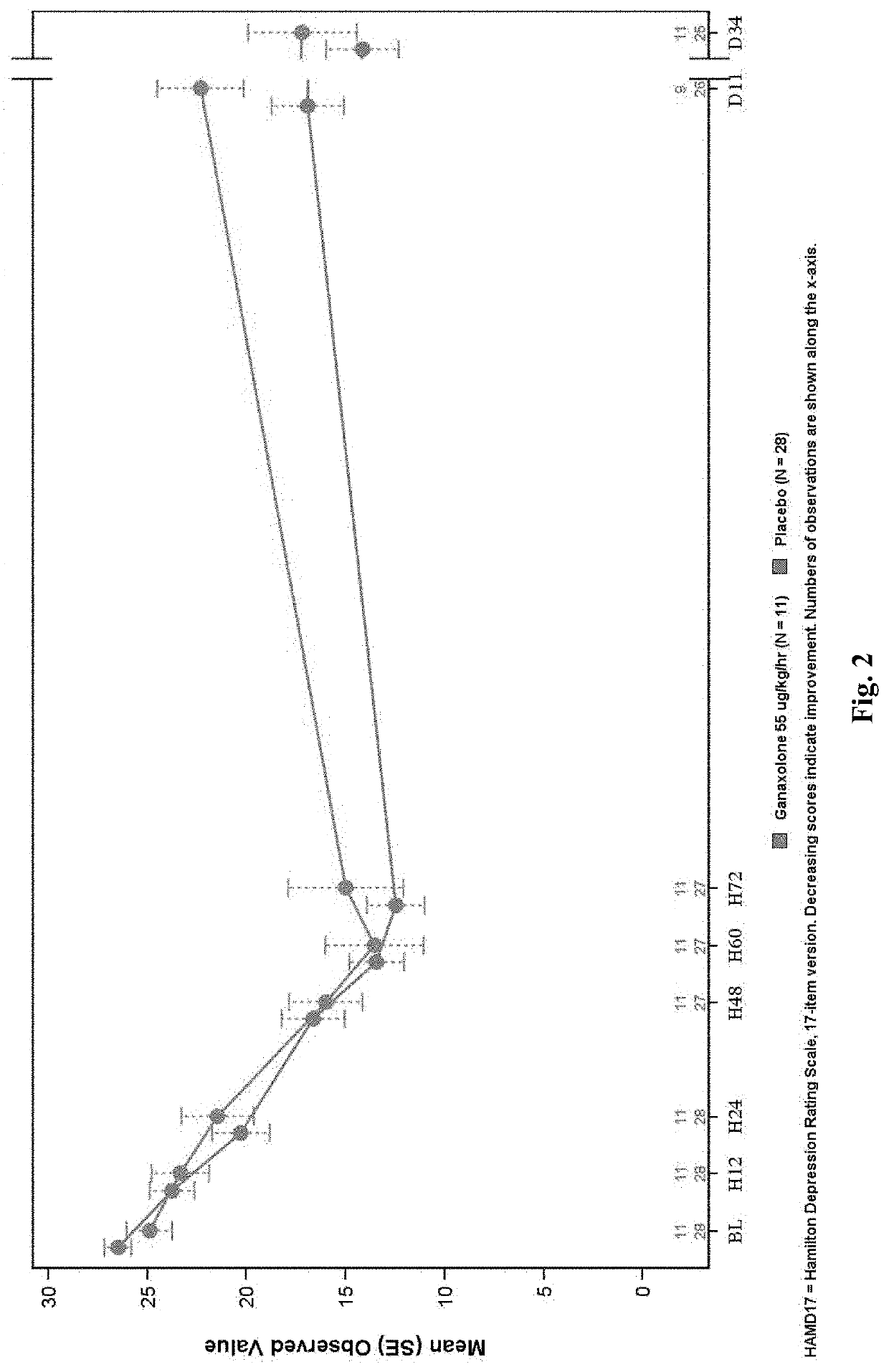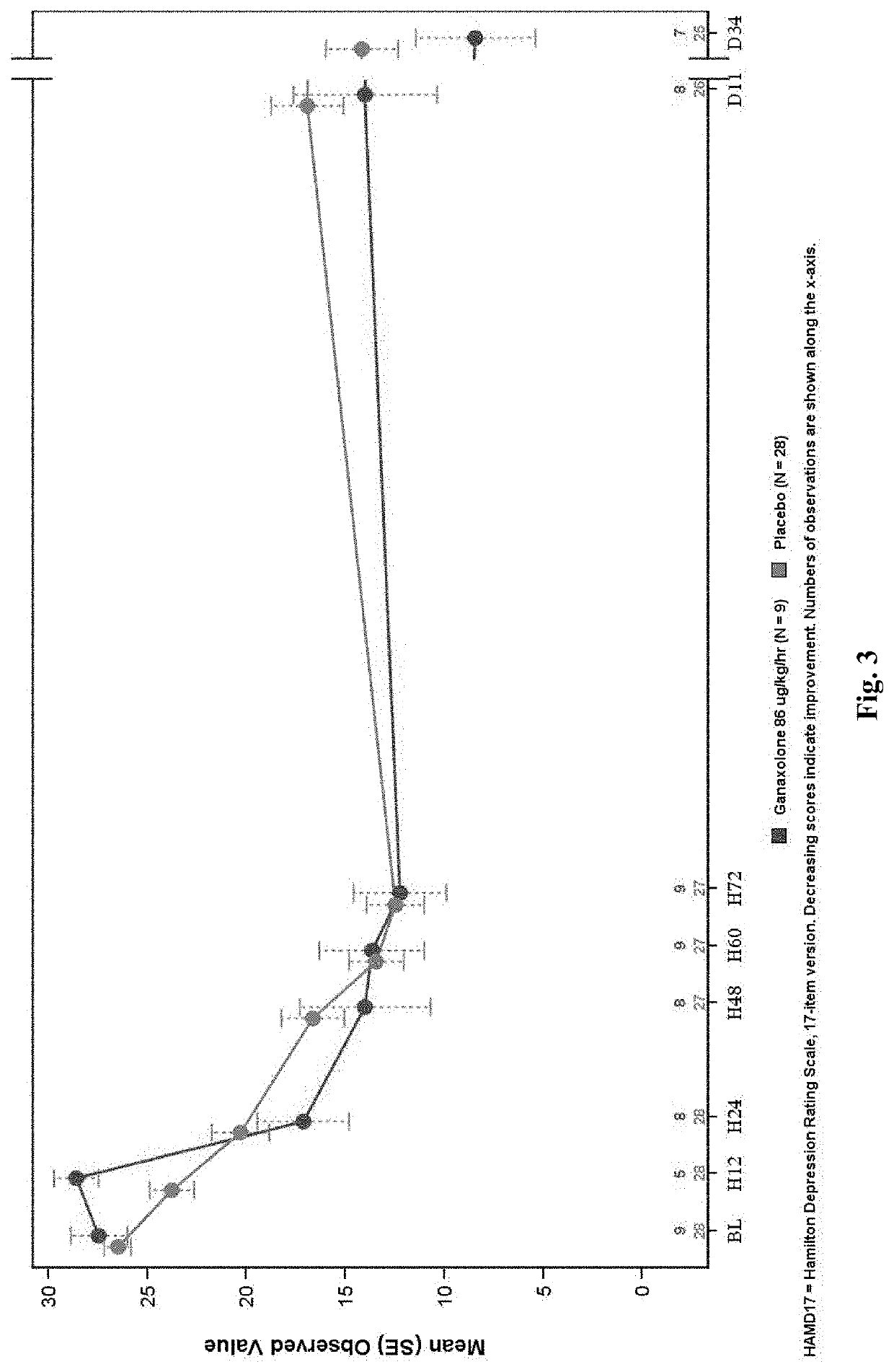Ganaxolone for use in prophylaxis and treatment of pospartum depression
a technology of ganaxolone and pospartum depression, which is applied in the direction of drug compositions, dispersed delivery, inorganic non-active ingredients, etc., can solve the problems of severe loss of consciousness, syncope and presyncope can be dangerous to the patient, etc., and achieve the effect of reducing an ham-d scor
- Summary
- Abstract
- Description
- Claims
- Application Information
AI Technical Summary
Benefits of technology
Problems solved by technology
Method used
Image
Examples
example 1 (
Dose Justification)
[0395]A Phase 1 study in healthy volunteers investigating the safety of IV ganaxolone, infusion of 30 mg / hr for 1 hour, 20 mg over 2 minutes and 20 mg / hr for 4 hours led to peak concentrations of 258, 441 and 215 ng / mL, respectively, without any safety concerns. Sedation was assessed using the Modified Observers Assessment of Alertness / Sedation (MOAAS) scale. On this scale, score 5 indicates no sedation (responds readily to name spoken in normal tone) while score 1 indicates deep sedation (responds only after painful trapezius squeeze). In these cohorts, vast majority of the scores were 5 with few exceptions of 4 (lethargic response to name spoken in normal tone) and 3 (responds only after name is called loudly or repeatedly). The sedation scores reversed quickly after the infusion was stopped. The highest bolus dose tested was 30 mg, which was infused over 5-minutes. This dose led to peak concentration levels (Cmax) of >1,000 ng / mL with no safety concerns (except...
example 2
A Phase 2A, Double-Blind, Placebo-Controlled, Multiple-Dose Escalation Study to Evaluate Safety, Pharmacokinetics and Efficacy of Intravenously and Orally Administered Ganaxolone in Women with Postpartum Depression
[0397]An objective of the study is to assess the safety and tolerability of escalating doses of intravenously and orally administered ganaxolone as determined by adverse events and changes from baseline in laboratory measures, vital signs, Columbia Suicide Severity Rating Scale (CSSRS), electrocardiogram (ECG), Stanford Sleepiness Scale (SSS), and physical examination.
[0398]Another objective of the study is to explore the efficacy of escalating doses of intravenously and orally administered ganaxolone in the treatment of PPD with the Hamilton Depression Rating Scale 17-item version (HAM-D17), Edinburgh Postnatal Depression Scale (EPDS), Spielberger State-Trait Anxiety Inventory 6-item version (STAI6) and Clinical Global Impression-Improvement (CGI-I) scale.
[0399]Approximat...
example 3
[0445]Approximately 172 women aged 18 to 48 years with PPD are screened, and approximately 88 subjects are enrolled into a Phase 2 clinical study. The enrolled subjects are assigned to five groups.
[0446]In the first group, approximately 8 subjects are titrated to a total daily oral dose of 900 mg ganaxolone per day (administered in three divided doses per day) over 10 days, followed by a taper over 4 days. For this group ganaxolone doses are titrated from 225 mg on Day 1 to a total daily oral dose of 900 mg starting on Day 7. The ganaxolone mean trough plasma concentrations during the Days 8, 9, and 10 are predicted to be about 40 ng / ml, based on PK modelling. Bedtime doses are selected to be higher than the daytime doses, and are expected to yield plasma mean peak concentrations up to 180 ng / ml during the night on Days 8, 9 and 10.
[0447]In the second group, approximately 20 subjects receive ganaxolone administered orally at bedtime (QHS). For these subjects, ganaxolone is titrated ...
PUM
| Property | Measurement | Unit |
|---|---|---|
| Mass | aaaaa | aaaaa |
| Mass | aaaaa | aaaaa |
| Mass | aaaaa | aaaaa |
Abstract
Description
Claims
Application Information
 Login to View More
Login to View More - R&D
- Intellectual Property
- Life Sciences
- Materials
- Tech Scout
- Unparalleled Data Quality
- Higher Quality Content
- 60% Fewer Hallucinations
Browse by: Latest US Patents, China's latest patents, Technical Efficacy Thesaurus, Application Domain, Technology Topic, Popular Technical Reports.
© 2025 PatSnap. All rights reserved.Legal|Privacy policy|Modern Slavery Act Transparency Statement|Sitemap|About US| Contact US: help@patsnap.com



